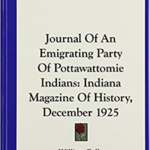The Potawatomi Trail of Death began Sept. 4, 1838. More than 850 Tribal members walked 660-miles from Indiana to Kansas at gun point, and 42 died along the way, mostly elders and children. The Potawatomi lacked access to supplies, with starvation and illness commonplace throughout the removal and at the new reservation. Written and visual records provide insight into this turbulent time and help present-day Potawatomi remember and honor their ancestors’ trials.
“When you have those resources and those memories, it is your duty to stop and remember and reflect and honor our ancestors for the struggles that they went through because if they didn’t push through the next day, if they didn’t take one more step, if they didn’t hold their children close for one more night, we wouldn’t be here,” said Dr. Kelli Mosteller in a 2020 Hownikan interview. Dr. Mosteller serves as the Citizen Potawatomi Nation’s Cultural Heritage Center director.
English artist George Winter captured the only known first-hand images of Native American removal during the Trail of Death. This book features Winter’s sketches, paintings, drawings and watercolor artwork that highlight the Potawatomi shortly before and during the forced removal. Although no longer in active print, numerous online retailers have the book available for purchase.
Federal official William Polke overlooked the forced emigration of Potawatomi through the Trail of Death. Polke’s journal provides insight into some of the day-to-day experiences the Potawatomi faced along the arduous 660-mile journey.
Several online retailers sell the Journal of An Emigrating Party of Pottawatomie Indians: Indiana Magazine Of History, December 1925. Access A Continuation of the Journal of an Emigrating Party of Potawatomi Indians, 1838, and Ten William Polke Manuscripts through research databases and libraries. Additionally, excerpts from Polke’s journal are published online at cpn.news/polke.
Father Benjamin Marie Petit served as a Catholic missionary to the Potawatomi and traveled with them on the Trail of Death. His journal entries across the three months included records of births, deaths and spiritual aspects, providing a slightly different viewpoint than Polke’s written records. Find this resource online and through research databases.
Dive deeper into the Trail of Death’s history by utilizing the Cultural Heritage Center’s archives at potawatomiheritage.com or touring its gallery Forced From Land and Culture: Removal.




